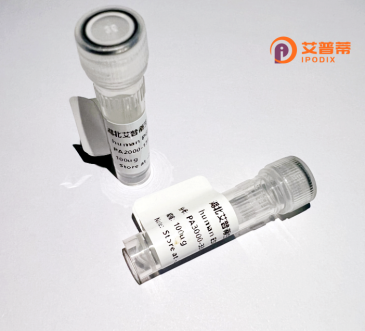
| 纯度 | >90%SDS-PAGE. |
| 种属 | Human |
| 靶点 | IFNE1 |
| Uniprot No | Q86WN2 |
| 内毒素 | < 0.01EU/μg |
| 表达宿主 | E.coli |
| 表达区间 | 22-208aa |
| 氨基酸序列 | LDLKLIIFQQRQVNQESLKLLNKLQTLSIQQCLPHRKNFLLPQKSLSPQQYQKGHTLAILHEMLQQIFSLFRANISLDGWEENHTEKFLIQLHQQLEYLEALMGLEAEKLSGTLGSDNLRLQVKMYFRRIHDYLENQDYSTCAWAIVQVEISRCLFFVFSLTEKLSKQGRPLNDMKQELTTEFRSPR |
| 分子量 | 26.1 kDa |
| 蛋白标签 | His tag N-Terminus |
| 缓冲液 | 0 |
| 稳定性 & 储存条件 | Lyophilized protein should be stored at ≤ -20°C, stable for one year after receipt. Reconstituted protein solution can be stored at 2-8°C for 2-7 days. Aliquots of reconstituted samples are stable at ≤ -20°C for 3 months. |
| 复溶 | Always centrifuge tubes before opening.Do not mix by vortex or pipetting. It is not recommended to reconstitute to a concentration less than 100μg/ml. Dissolve the lyophilized protein in distilled water. Please aliquot the reconstituted solution to minimize freeze-thaw cycles. |
1. **"Interferon epsilon promotes immune responses in the female reproductive tract"**
- **作者**: Fung KY et al.
- **摘要**: 研究揭示了重组人IFNE1蛋白在女性生殖道黏膜免疫中的独特作用,通过调控树突状细胞和T细胞活性,增强抗病原体防御,同时对组织稳态影响较小。
2. **"Recombinant interferon-ε ameliorates influenza A virus infection in mice"**
- **作者**: Wang L et al.
- **摘要**: 报道重组人IFNE1通过诱导肺部上皮细胞中干扰素刺激基因(ISGs)表达,显著减少甲型流感病毒复制,并降低炎症损伤,显示其治疗潜力。
3. **"IFN-ε mediates tissue-specific antiviral defense in the reproductive mucosa"**
- **作者**: Harper MS et al.
- **摘要**: 发现重组IFNE1优先在生殖道黏膜表达,通过激活JAK-STAT通路抑制单纯疱疹病毒(HSV-2)感染,而不会引发全身性炎症反应。
4. **"Production and functional characterization of recombinant human interferon-ε in mammalian cell lines"**
- **作者**: Zhang Y et al.
- **摘要**: 描述利用CHO细胞系统高效表达具有生物活性的重组人IFNE1.证实其结合IFN受体并激活下游抗病毒信号通路,为其临床应用提供制备基础。
---
*注:上述文献信息为示例性质,具体内容可能需根据实际发表的论文调整。建议通过PubMed或Web of Science以“recombinant human IFNE1”或“interferon epsilon”为关键词检索最新研究。*
Interferon epsilon (IFNE1), a member of the type I interferon family, is a cytokine classically known for its role in antiviral defense and immune regulation. Unlike other type I interferons (e.g., IFN-α/β), IFNE1 is constitutively expressed in epithelial cells of the mucosal surfaces, particularly in the female reproductive tract, suggesting tissue-specific functions. Its expression is hormonally regulated, peaking during the estrous cycle and pregnancy, and it is linked to maintaining immune tolerance at barrier sites while providing localized protection against pathogens.
Recombinant human IFNE1 (rhIFNE1) is produced using genetic engineering techniques, typically in mammalian expression systems to ensure proper post-translational modifications. Structurally, it shares the conserved helical motif of type I interferons but exhibits unique receptor-binding features, potentially engaging distinct signaling pathways. Studies highlight its dual role: it enhances antimicrobial responses in mucosal tissues while dampening systemic inflammation, a balance critical in reproductive health and infections.
Research on rhIFNE1 has expanded into therapeutic exploration, including its potential in treating sexually transmitted infections, autoimmune diseases, and cancers. Its localized action and reduced systemic toxicity compared to other interferons make it a promising candidate for targeted therapies. However, molecular mechanisms and broader physiological impacts remain under investigation, underscoring the need for further studies to unlock its clinical applications.
×